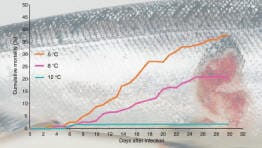 Cumulative mortality (%) of Atlantic salmon in seawater at 5, 8 or 12 °C bathchallenged with winter ulcer bacteria Moritella viscosa grown at 4, 8 or 12 °C. |
Several bacteria have been isolated from diseased fish, such as Moritella viscosa, Vibrio wodanis and Tenacibaculum ssp. Non-optimal conditions in net cages, e.g. high fish density and poor water exchange, can make the fish more susceptible to disease.
Tests at Fiskeriforskning have shown that healthy salmon infected with M. viscosa both develop sores and suffer mortality. Development of sores and mortality depend on the growth temperature of the bacteria, which are most virulent at low temperatures (<: 10° C) but lose this ability at 12 °C (Fig. 1). This corresponds with experiences in the industry: Outbreaks of winter ulcer are common during winter when the sea temperature is below 7 °C.
Fiskeriforskning and the National Veterinary Institute will together study the virulence mechanisms of bacteria isolated from salmon suffering from winter ulcer. Bacteria surfaces have proteins and lipopolysaccharides, whose compositions change due to environmental conditions of the
bacteria. A bacterium grown inside a fish will produce different surface structures than a bacterium grown under good conditions in artificial broth.
A vaccine contains killed bacteria, and the fishs immune system will produce antibodies and immune cells specific to the surface structures. The fish can now recognise the bacteria in the first stage of the infection and can remove them before disease develops. But if the bacteria in the vaccine differ from the infecting strain, the immune system will not recognise the bacteria and the disease can develop.
Salmon have been vaccinated against M. viscosa since 1999, but the effect has not been optimal. We will study which surface structures the bacteria are producing under growth conditions that copy the conditions inside the fish. Such knowledge is important for developing a more efficacious vaccine.
July 2006


